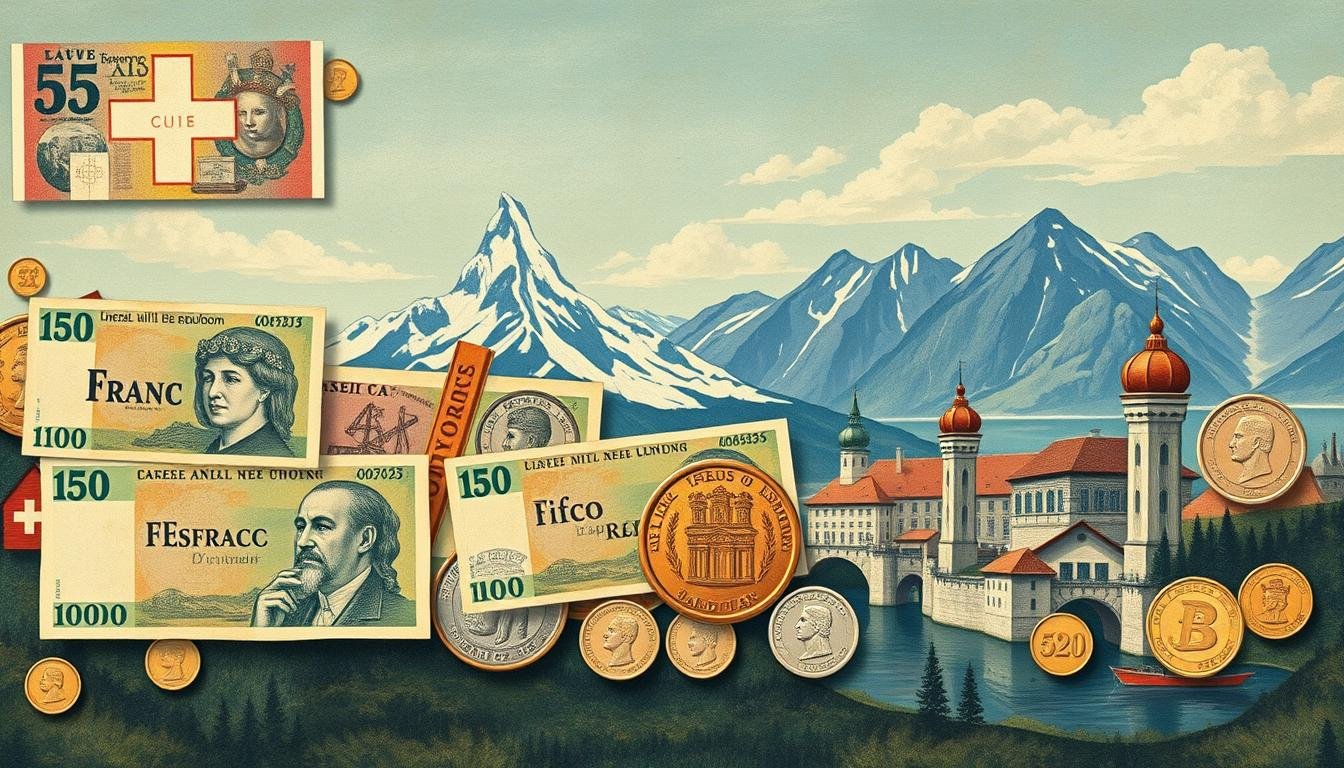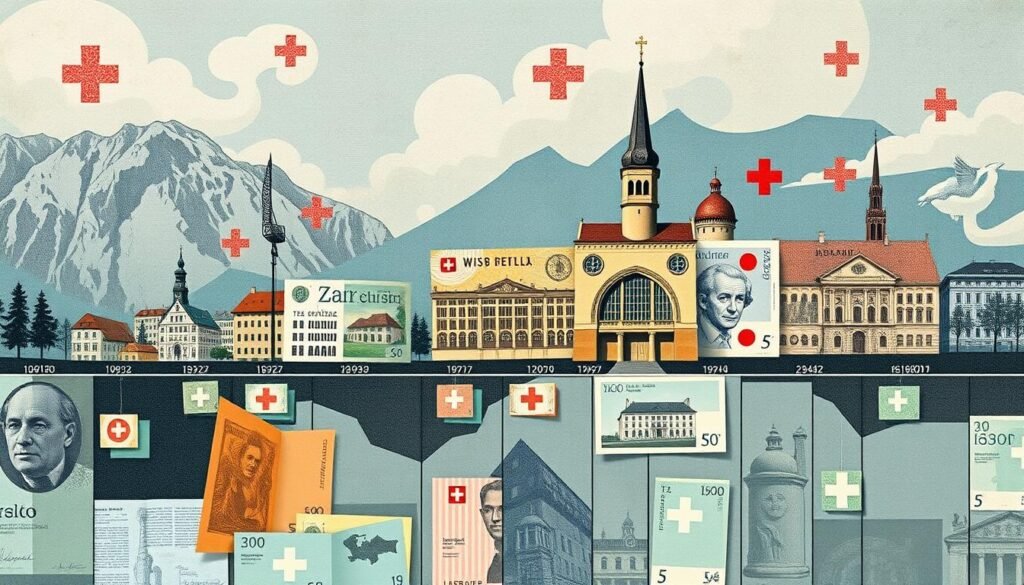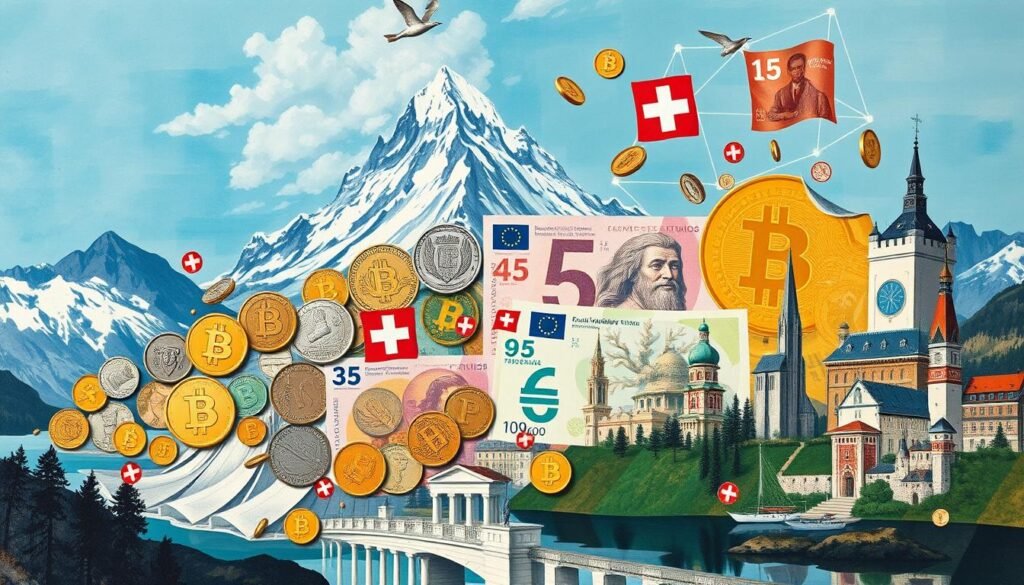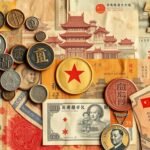
Exploring Switzerland’s currency history reveals the Swiss franc as the official currency, divided into 100 cents, or “rappen” in Swiss-German1. The Swiss franc’s rich history offers insights into Switzerland’s economic growth. You can trace its evolution from its introduction in 1798 to today. The Swiss National Museum sheds light on the currency’s past, noting that before 1798, about 75 entities minted coins, leading to over 860 different currencies in use1.
Delving deeper, you learn the Swiss franc is the official currency in Switzerland, Liechtenstein, and Campione d’Italia2. The symbol “CHF” for “Confoederatio Helvetica” reflects Switzerland’s linguistic diversity2. You can discover the various coinage systems and denominations used throughout history. The Swiss franc became the monetary unit in Switzerland on May 7, 18501.
Key Takeaways
- The official currency of Switzerland is the Swiss franc, subdivided into 100 cents.
- The Swiss franc has a rich history, dating back to its introduction in 1798.
- The Swiss National Museum provides valuable information on the history of Swiss currency.
- The Swiss franc serves as the official currency in three locations: Switzerland, Liechtenstein, and Campione d’Italia.
- The Swiss currency symbol “CHF” stands for “Confoederatio Helvetica,” reflecting Switzerland’s multilingual identity.
- Understanding what is the history of Switzerland’s currency can provide valuable insights into the country’s economic development.
Early Currency Systems in Swiss Territories
The Swiss monetary system has seen significant transformations over the years, influencing the development of Swiss currency. Before 1798, around 75 entities were minting coins in Switzerland. This included 25 cantons and half-cantons, 16 cities, and 34 abbeys3. This diversity led to a complex system with over 860 different coins in circulation, each with its own value and denomination3.
The Helvetic Republic’s monetary system, introduced in 1798, was a major turning point. The Helvetic frank, valued at 1.48 French francs, was divided into 10 batzen or 100 rappen4. This decimal system unified the monetary system across Switzerland for the first time4.
The Swiss franc, introduced in 1798, was modeled after the Bern livre. Initially valued at approximately 1.48 French francs, it contained 6.67 grams of fine silver3. The Swiss National Bank (SNB) works to keep inflation low, solidifying the Franc’s reputation as a stable currency5. The Swiss franc is divided into 100 centimes (or Rappen in German), reflecting the country’s efforts towards a standardized national currency5.
The Swiss monetary system’s development has been shaped by various factors, including the introduction of new coins and banknotes. Coins are available in denominations of 5, 10, 20, and 50 centimes, as well as 1, 2, and 5 Francs5. Banknotes are issued in denominations of 10, 20, 50, 100, 200, and 1,000 Francs5. The current series of Swiss banknotes, introduced in 2016, features advanced security measures like microtext and watermarks5.
The Birth of Modern Swiss Currency
The Swiss Federal Constitution of 1848 stated that only the federal government could issue money6. This was a key moment in the Swiss franc development, setting the stage for the modern currency system. The Swiss franc was introduced as the national currency in 185076. It has been Switzerland’s main currency ever after7.
The historical Swiss coins were vital in shaping the country’s monetary system. The shift from cantonal coins to a unified currency happened in 18488. The Federal Coinage Act of 1850 ushered in the modern Swiss franc7. Today, the Swiss franc is widely recognized and traded worldwide. Its value has fluctuated between 0.98 to 1.20 USD, 1.07 to 0.94 EUR, and around 66 to 95 INR over the last decade7.
Here is a summary of the key events in the development of the Swiss franc:
- 1848: The Swiss Federal Constitution specifies that the federal government is the only entity authorized to issue money6.
- 1850: The introduction of the Swiss franc as a national currency76.
- 1850: The Federal Coinage Act marks the birth of the modern Swiss franc7.
What is the History of Switzerland’s Currency: Key Milestones
The history of Switzerland’s currency is a captivating tale. It includes the introduction of the Swiss franc, the founding of the Swiss National Bank, and the growth of the monetary system. These events have significantly influenced Switzerland’s economic stability. The Swiss franc was introduced in 1850, shortly after the modern Swiss state was established in 18489. This marked a significant milestone, as it replaced 860 distinct currencies that were previously in circulation10.
The introduction of the Swiss franc was a critical step towards establishing a unified monetary system in Switzerland. The Swiss National Bank was established in 1907, playing a vital role in the development of the Swiss monetary system10. The bank is responsible for issuing Swiss banknotes and coins, and it has implemented various measures to prevent counterfeiting. Each banknote features unique designs and security features to prevent counterfeiting11. The 2016 series of Swiss banknotes includes themes relating to nature, culture, and humanity, with specific themes assigned to each denomination.
The history of Switzerland’s currency is closely tied to the development of Swiss banknotes origins. The Swiss franc is divided into 100 cents, with coins in circulation for 5, 10, and 20 cents, and denominations of 0.5, 1, 2, and 5 francs10. Current banknotes are available in denominations of 10 CHF, 20 CHF, 50 CHF, 100 CHF, 200 CHF, and 1,000 CHF. The CHF has seven security markings on each bill, making it highly resistant to counterfeiting11. The exchange rate fluctuation leads to Swiss exports becoming more expensive; foreign buyers pay more CHF for the same amount of products11.
| Denomination | Security Features |
|---|---|
| 10 CHF | Watermark, security thread, and microprinting |
| 20 CHF | Watermark, security thread, and microprinting |
| 50 CHF | Watermark, security thread, and microprinting |
| 100 CHF | Watermark, security thread, and microprinting |
| 200 CHF | Watermark, security thread, and microprinting |
| 1,000 CHF | Watermark, security thread, and microprinting |
Evolution of Swiss Banknotes Through Time
The evolution of Swiss currency is a captivating tale that mirrors the nation’s deep history and its dedication to progress. Each series of Swiss banknotes boasts its own distinct design and security measures. The Swiss National Bank has introduced various series over the years, highlighting a focus on security and authenticity12.
The initial series of Swiss banknotes, launched in 1907, included a 1000-franc note with dimensions of 215 × 132 mm12. Subsequent series saw changes in size, with the second series, from 1911-1914, featuring 1000-franc notes at 216 × 131 mm12. The Swiss National Bank has also introduced significant design updates and security enhancements to combat counterfeiting.
Key features of Swiss banknotes include:
- Unique design and security features for each series
- Advanced security features to prevent counterfeiting
- Regular updates to stay ahead of counterfeiters
The evolution of Swiss currency showcases the nation’s unwavering commitment to innovation and security. As you further explore the history of Swiss money, you’ll appreciate the evolution of Swiss banknotes and their importance in the realm of currency12.

The Swiss National Bank has declared several older series of banknotes to be no longer legal tender after newer series were introduced12. Yet, these banknotes can be exchanged for valid notes at the National Bank for up to 20 years post-recall. The eighth series, issued between 1995 and 1998, was officially recalled on 30 April 202112. As the evolution of Swiss currency progresses, it will be intriguing to observe how the Swiss National Bank responds to new technologies and security challenges to maintain the integrity of the Swiss franc.
Switzerland’s Gold Standard Era
Switzerland’s entry into the Latin Monetary Union linked its currency to gold, shaping the Swiss franc history and historical Swiss coins. This gold standard era profoundly influenced the Swiss economy13.
The gold standard era started in 1880, with a fixed gold parity of 1,000 Swiss francs to 1 kilogram of gold13. Switzerland focused on currency stability, with an inflation rate under 2% annually13.
Some key statistics from this era include:
- Average annual growth rate of 2.5% between 1880 and 191413
- Gold reserves around 40% of total currency in circulation during peak years13
- Approximately 80% of foreign reserves in gold by the Swiss National Bank in the early 20th century13
The transition off the gold standard started in 1914, with World War I’s onset. By war’s end, gold reserves plummeted to nearly 25% of total reserves due to extensive money printing13.
Grasping the gold standard era is key to understanding the Swiss franc history and historical Swiss coins. It had a lasting effect on Switzerland’s monetary system and economy13.
The Swiss Franc During World Wars
The Swiss franc maintained stability during World War II, amidst Europe’s economic chaos14. This stability is a result of the Swiss monetary system’s evolution. The Swiss currency’s development has been influenced by the country’s history, economic policies, and international relations.
Several factors contributed to the Swiss franc’s stability during World War II. Switzerland’s neutral stance and stable economy played a significant role15. The currency’s peg to the euro also helped maintain its value16. The Swiss National Bank’s policies were instrumental in keeping the currency stable, mitigating war’s economic impact.
Here are some key statistics illustrating the Swiss franc’s stability during World War II:
- The Swiss franc remained stable, with an inflation rate of only 0.4 percent in 201916.
- Switzerland’s GDP grew significantly, with a total worth of US$750 billion in 202016.
- The foreign exchange market, where Swiss francs are traded, exceeds $1.5 trillion in daily transactions16.
The Swiss franc’s stability during World War II showcases the strength of the Swiss monetary system. The country’s ability to maintain a stable economy and currency has made it a preferred destination for investors. It also serves as a safe haven for those looking to protect their assets.
| Year | Inflation Rate | GDP |
|---|---|---|
| 2019 | 0.4% | $743 billion |
| 2020 | 0.5% | $750 billion |
Development of Modern Swiss Monetary Policy
The Swiss National Bank has been instrumental in shaping modern Swiss monetary policy. It has contributed significantly to the stability of the Swiss franc and the overall economy17. The bank aims to maintain price stability in the medium term. It does this by fully utilizing Switzerland’s production capacity17.
Adjusting interest rates according to economic capacity helps smooth out cyclical fluctuations in economic activity17. This approach ensures a stable economic environment.
The Swiss franc is renowned as one of the strongest currencies worldwide. It serves as a safe haven for international capital flows18. The Swiss National Bank’s monetary policy framework has undergone significant changes over the years. These changes reflect both historical continuity and strategic adaptations18.
Key aspects of Swiss monetary policy include disinflation from 1973 to 1983. The transition from inward exchange controls to money supply management under floating exchange rates is also noteworthy18.
Some notable features of the Swiss monetary system include:
- Two-thirds of Swiss goods are destined for the European Union17
- 75% of Swiss imports are derived from the European Union17
- The Swiss franc appreciated by 28% against the currencies of its major trading partners from August 1992 to September 199517
The evolution of modern Swiss monetary policy is deeply connected to the country’s Swiss money background and the Swiss franc development. Grasping these elements is vital for understanding the Swiss monetary system’s complexity. It also highlights its significant impact on the global economy18.
Swiss Currency Security Innovations
Exploring historical Swiss coins and the origins of Swiss banknotes reveals the advanced security measures protecting the currency. The Swiss National Bank has implemented cutting-edge anti-counterfeiting technologies to safeguard Swiss banknotes19. These technologies include 13 innovative security features in the 8th and 9th banknote series. This makes it challenging for counterfeiters to mimic the notes19.
The design of the new Swiss banknotes spanned 11 years, from the first design competition in 2005 to their release in 201620. Manuela Pfrunder, the lead graphic designer, incorporated various security elements. For example, the 200-Franc note features a security strip showing Switzerland’s geological ages20. The 50-Franc note lists the names of the Swiss Alps’ four-thousand-metre peaks in alphabetical order, adding an extra layer of security20.
Switzerland also employs digital security measures to combat counterfeiting. The banknotes are produced using advanced technology, making counterfeiting difficult19. The success rate in tracing counterfeiters is nearly 100%, with almost all cases leading to successful identification19.
For more information on the Swiss franc and its history, visit this website. It offers a detailed look at the currency’s origins and evolution. The Swiss franc is renowned for its stability, thanks to Switzerland’s neutrality and strict monetary policies.
The following table highlights some of the key security features of the new Swiss banknotes:
| Banknote | Security Feature |
|---|---|
| 50-Franc note | Names of four-thousand-metre peaks in the Swiss Alps |
| 100-Franc note | Security strip listing Swiss rivers and their lengths |
| 200-Franc note | Security strip depicting the geological ages of Switzerland |
These advanced security features have significantly enhanced the security and authenticity of Swiss banknotes. They make the Swiss currency one of the most secure globally20.
The Swiss Franc as a Global Safe Haven
The Swiss franc is viewed as a safe-haven currency, thanks to Switzerland’s stable economy and monetary system21. This stability is evident in the Swiss franc’s ranking as the seventh most traded currency globally21. The country’s robust banking system, minimal inflation, and high living standards further solidify its reputation as a safe-haven currency.
The Swiss franc’s strength is deeply rooted in its history, closely linked to the history of Switzerland’s currency. Grasping the Swiss franc history is key to understanding its current standing. The currency has maintained stability, with a low inflation rate of 0.4 percent in 201921. Switzerland’s nominal GDP was estimated at nearly US$750 billion in 202021.
International Banking Relations
The Swiss franc’s status as a safe-haven currency is also bolstered by its international banking relations. Approximately 28 percent of all offshore funds are stored in Switzerland21. This is largely due to Switzerland’s robust banking system and strict banking secrecy laws. The Swiss Central Bank’s policies, such as the former requirement that 40% of reserves be held in gold, have also contributed to the currency’s stability22.
Currency Strength Factors
Several factors contribute to the Swiss franc’s strength. These include its low inflation rate, high standard of living, and strong banking system. The service sector makes up about 74 percent of Switzerland’s total GDP21. The Swiss franc’s exchange rate against the euro has remained relatively stable21. Overall, the Swiss franc’s reputation as a safe-haven currency is well-deserved, with its history of Switzerland’s currency and Swiss franc history being essential to its current status22.
Recent Challenges and Changes
The evolution of Swiss currency has been influenced by several factors, including shifts in monetary policy23. As of April 2024, Switzerland’s inflation rate has risen to 1.4%, from 1.1% the month before23. This uptick in inflation is a critical element of the Swiss money background, affecting the economy and currency value.
The Swiss National Bank has implemented various policy changes to keep inflation low and foster economic stability23. The Swiss franc is seen as a “safe haven” currency during economic turmoil, boosting demand for CHF23. Despite the end of gold backing in 2000, the SNB retains substantial gold reserves, a significant asset23.
Key aspects of the Swiss economy and currency include:
- Low national debt and fiscal prudence, bolstering the Swiss franc’s strength24
- A stable economy with low unemployment and high per capita income24
- A significant contribution from the financial services sector to GDP24
The evolution of Swiss currency is deeply connected to the country’s economic stability and monetary background, making it appealing to investors and a reliable value store24.

Recent economic and monetary policy shifts have significantly influenced the Swiss currency’s evolution and the broader Swiss money background23.
| Category | Description |
|---|---|
| Inflation Rate | 1.4% as of April 202423 |
| Monetary Policy | Changes introduced by the Swiss National Bank to maintain low inflation and stable economic growth23 |
| Swiss Franc | Considered a “safe haven” currency during global economic uncertainty23 |
Digital Evolution of Swiss Currency
The Swiss franc’s development has been influenced by historical coins and the country’s stance on digital currencies. The Swiss National Bank is now exploring digital currencies and blockchain technology25. This move aims to improve payment systems and ensure safe transactions.
The rise of cryptocurrencies like Bitcoin, Ethereum, and Ripple is also driving the digital evolution of Swiss currency26. In response, the Swiss National Bank has initiated a digital Swiss franc pilot. Six Swiss banks are participating in this project26. The goal is to create a digital currency that is both secure and efficient.
Some key features of the digital Swiss franc pilot include:
- Launch date: December 1st26
- Number of participating banks: 626
- Platform for transactions: SIX Digital Exchange (SDX)26
The digital transformation of the Swiss currency will significantly impact the country’s economy and financial system. As the world shifts towards digital transactions, the Swiss National Bank must lead the way. They need to provide a secure and efficient method for conducting transactions25.
Conclusion: The Legacy and Future of Swiss Currency
The Swiss franc’s history is rich and storied, solidifying its status as a globally trusted currency27. Over 70% of Swiss banknotes are held abroad, highlighting the currency’s appeal to the wealthy worldwide27. Its security is unmatched, with more than 25 counterfeiting safeguards in place27.
As we look ahead, the Swiss currency is set to evolve, integrating digital innovations while upholding its values of prudence and financial discipline28. Amidst the digital money shift, the Swiss Franc remains a symbol of stability, with a substantial portion of its reserves backed by gold27. The Swiss banking system, celebrated for its wealth management prowess and tailored strategies, continues to be a reliable ally for investors29.
The Swiss franc’s legacy reflects Switzerland’s steadfast dedication to economic stability and wise monetary policies29. As Switzerland faces the digital era’s challenges, the Swiss franc will undoubtedly remain a pillar of financial security. It will continue to bolster Switzerland’s standing as a global financial safe haven272928.
FAQ
What is the history of Switzerland’s currency?
What were the early currency systems used in Swiss territories?
When was the modern Swiss currency introduced?
What are the key milestones in the history of Switzerland’s currency?
How has the design and security of Swiss banknotes evolved over time?
What was the impact of the gold standard on the Swiss currency?
How did the World Wars affect the Swiss franc?
What is the role of the Swiss National Bank in the country’s monetary policy?
What security features have been introduced to protect the Swiss currency?
Why is the Swiss franc considered a global safe-haven currency?
What are the recent challenges and changes affecting the Swiss franc?
How is the digital evolution shaping the future of the Swiss currency?
Source Links
- Interesting facts about the Swiss franc – https://www.globalexchange.hk/en/web/42738/the-swiss-franc
- Know Your Money in Switzerland: 14 Interesting Swiss Franc Facts – Studying in Switzerland – https://studyinginswitzerland.com/swiss-franc-facts/
- Swiss franc – https://en.wikipedia.org/wiki/Swiss_franc
- Centre for History and Economics – https://www.histecon.magd.cam.ac.uk/coins_Oct2024.html
- Switzerland Currency – https://onemoneyway.com/en/dictionary/switzerland-currency/
- Regulated free banking in Switzerland (1881–1907) – Swiss Journal of Economics and Statistics – https://sjes.springeropen.com/articles/10.1186/s41937-021-00078-w
- Swiss francs – https://www.iamexpat.ch/lifestyle/about-switzerland/swiss-francs
- Britannica Money – https://www.britannica.com/money/coin/Switzerland
- Switzerland and its money – https://blog.nationalmuseum.ch/en/2020/08/swiss-franc/
- Swiss Franc (CHF) – https://corporatefinanceinstitute.com/resources/foreign-exchange/swiss-franc-chf/
- The Currency Story of the Swiss Franc – https://www.ebc.com/forex/the-currency-story-of-the-swiss-franc
- Banknotes of the Swiss franc – https://en.wikipedia.org/wiki/Banknotes_of_the_Swiss_franc
- A Chronological Review of Swiss Monetary History in the Nineteenth and Twentieth Centuries (Part II) – Swiss Monetary History since the Early 19th Century – https://www.cambridge.org/core/books/swiss-monetary-history-since-the-early-19th-century/chronological-review-of-swiss-monetary-history-in-the-nineteenth-and-twentieth-centuries/80CA1F2EBB68B18E047236CB1BA2339E
- Switzerland Currency (Swiss Franc History + Facts) – WhiteboardCrypto – https://whiteboardcrypto.com/switzerland-currency/
- The Swiss franc (CHF) – The history and advantages of a strong currency – https://www.b-sharpe.com/en/blog/why-swiss-franc-strong-currency/
- The Swiss Franc: What You Should Know – Blocs — Framer UI Kit – https://bound.co/blog/the-swiss-franc
- PDF – https://preserve.lehigh.edu/_flysystem/fedora/2023-12/303984.pdf
- Swiss Monetary History since the Early 19th Century – https://www.cambridge.org/core/books/swiss-monetary-history-since-the-early-19th-century/6BD520478FB6C2BC9C9A859CC008C0CF
- Counterfeit money today – not a thriving business in Switzerland – https://blog.nationalmuseum.ch/en/2017/07/counterfeit-money-today-not-a-thriving-business-in-switzerland/
- Here’s what you can see on the Swiss Francs | i-vest by Alpian – https://www.blog.alpian.com/trends/switzerland/time-light-wind-matter-heres-what-you-can-see-on-the-swiss-francs-in-your-pocket
- CHF | Swiss Franc | OANDA – https://www.oanda.com/currency-converter/en/currencies/majors/chf/
- Swiss Franc 101: History and 6 Facts About Swiss Currency – https://blog.remitly.com/currencies/swiss-franc/
- Currency in Switzerland – https://my-swiss-company.com/en/currency-in-switzerland/
- How & Why the Swiss Franc is a Stable Currency – Blocs — Framer UI Kit – https://bound.co/blog/swiss-franc-stable-currency
- No title found – https://www.snb.ch/en/snb-explained/swiss-franc
- Swiss Franc Enters the Cryptocurrency Arena — Embracing Digital Transformation – https://goldblum.ch/news-and-media/swiss-franc-is-becoming-a-cryptocurrency
- What you can learn from the Swiss Currency, the Swiss Franc. 🇨🇭 – https://nuovoachilles.substack.com/p/what-you-can-learn-from-the-swiss
- Jean-Pierre Roth: 2003 – a year of renewal (Central Bank Articles and Speeches) – https://www.bis.org/review/r040503a.pdf
- Swiss Banking: A Legacy of Trust and Innovation – LFA – https://lfa.ch/wealth-management/swiss-banking-a-legacy-of-trust-and-innovation/







Interesting read indeed! But wouldnt it be more fascinating if the article also explored the impact of these currency changes on Switzerlands economy over the years? Just a thought.
Agreed! Switzerlands economy is a crucial lens missed here. Its all interconnected after all.
Interesting read! But isnt it odd that the Swiss Franc, being such a stable currency, isnt more widely adopted? Wonder how the global economy would react to that. Food for thought!
Interesting read but I wonder, given Switzerlands history of neutrality, how did global wars affect their currency? Its not clear from the article. Im curious about the impact.